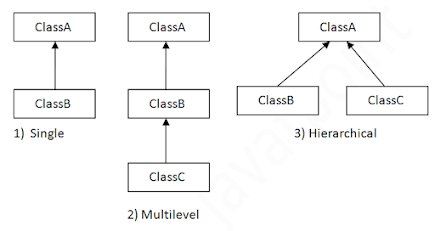Introduction
If the one object can acquires all the properties and behaviour of parent object then it's called Inheritance. The idea behind inheritance concept is, we can create a new class which is build upon existing one so we can reuse the methods and field of the parent class and also create new method in child class. Inheritance is use for method overriding and code reusability concepts. To create new child class from parent class we use the extends keyword. Syntax of define inheritace is as follow:
There are different types of inheritance in java as follows:
- Single Inheritance.
- Multilevel Inheritance.
- Hierarchical Inheritance.
1. Single Inheritance:
A class/parent class inherits another class/child class is called Single inheritance. For example,
class Animal{
void eat(){System.out.println("eating...");}
}
class Dog extends Animal{
void bark(){System.out.println("barking...");}
}
public class Single {
public static void main(String[] args) {
Dog d=new Dog();
d.bark();
d.eat();
}
}
OUTPUT:
barking...
eating...
2. Multiple Inheritance:
A chain of inheritance is called as Multiple inheritance. For example,
class Animal1{
void eat(){System.out.println("eating...");}
}
class Dog1 extends Animal1{
void bark(){System.out.println("barking...");}
}
class BabyDog extends Dog1{
void weep(){System.out.println("weeping...");}
}
public class Multilevel {
public static void main(String[] args) {
BabyDog d=new BabyDog();
d.weep();
d.bark();
d.eat();
}
}
3. Hierarchical Inheritance:
A two or more classes inherits a single class then it's called hierarchical inheritance. For example,
class Animal2{
void eat(){System.out.println("eating...");}
}
class Dog2 extends Animal2{
void bark(){System.out.println("barking...");}
}
class Cat extends Animal2{
void meow(){System.out.println("meowing...");}
}
public class Hierarchical {
public static void main(String[] args) {
Cat c=new Cat();
c.meow();
c.eat();
//c.bark();//C.T.Error
}
}
OUTPUT:
meowing...
eating...

Comments
Post a Comment